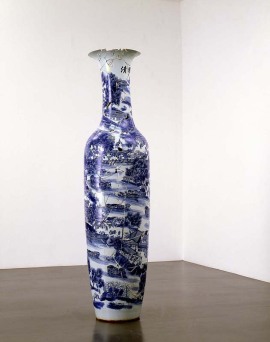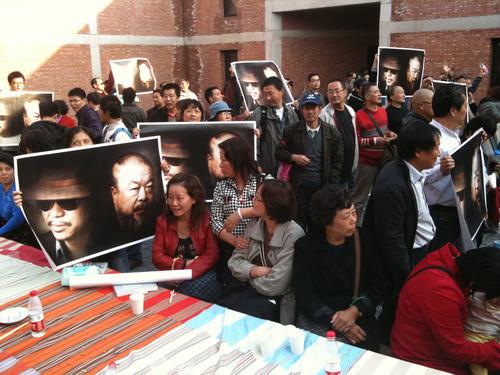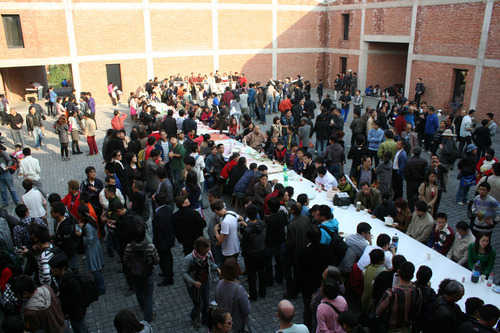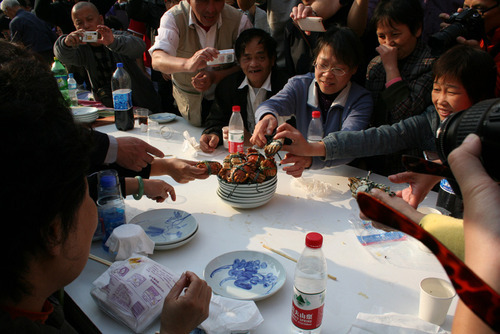31.3.11
Andy Warhol in China The Photographs of Christopher Makos Timezone 8 Foreword by Ai Weiwei. Introduction by Peter Wise. Interview with Christopher Makos. pub date: 2008
23.3.11
Circle of Animals/Zodiac Heads
"Sina's Shameless Cheating"
Ai Weiwei Gave "Shameless Cheating" Banners to Sina.com
(you tube)
Well-known Chinese artist Ai Weiwei and supporters rushed to the 2010 "Art Power List" ceremony site, to present the organizers with many silk banners with "Sina's Shameless Cheating" on them to protest against Sina's black-box selection.
Sina.com launched 「Art Power List" contest on Jan. 26. Ai Weiwei received an overwhelming amount of votes.
However, one day later, on Jan. 27, the webpage displaying the voting results disappeared.
The webpage suddenly resurfaced on Feb. 15.
Within "Artists of the Year" category, however, Ai Weiwei's name has completely disappeared.
In the category "Art Institutions of the Year", Three Shadows Photography Art Center was picked.
Perhaps Sina didn't realize that Ai Weiwei is actually the center's consultant.
The next day, many netizens voted for the center. With over 5,000 votes, Three Shadows topped the list.
At 8 p.m. on the same day, the organizer Sina.com changed the votes received by the 1st runner-up from around 3,400 votes to over 5,000 votes. Three Shadows' votes were reduced to 4,500 or so. Many netizens made screenshots as proof.
On Feb. 17, many called Sina.com to question about the altered votes, but Sina.com refused to disclose details.
On Feb. 21, on the award ceremony, Ai Weiwei and his supporters arrived at the scene,
and presented many banners to the organizers, with words "Sina's Shameless Cheating".
Well-known Chinese musician "Little Left Curse":
The whole process is ridiculous and very humorous. In the cold, people lined up to take photos with Ai, because the banner at the back said Sina is shameful.
Ai Weiwei said, many so-called artists bow to power. They have done so many detrimental things.
Yet they still want to obtain the honors. There are struggles in many countries to bring such people down.
Ai: In fact, China has no real contemporary art, because the contemporary art is closely linked to social realities and the openness of the society. When a country blocks and oppresses all this, the platform for arts cannot really exist.
On Feb. 19, Sina.com announced the award ceremony. Ai openly asked for netizens' opinions online.
Many netizens found that as an open network media, Sina.com carried out unfair black-box selections.
Sina.com bowed to the CCP's Propaganda Bureau and 「self-castrated」. As a media, it lost credibility.
"Little Left Curse" said, art should be more entertaining, and should allow everyone to participate.
Open and fair rules should be established. He believes Sina.com may have unspeakable difficulties, because
they are monitored by the Propaganda Bureau.
NTD reporter Tang Yan and Xue Li
NEVER SORRY Screenings For The People, By The People
Request screenings of NEVER SORRY and bring the film to theaters near you. Simply go to the "Request Screenings" page on our website and tell us where you would like to see the film. Pass it on to your friends -- the more demand we get, the more likely the film will come to you!
Who's afraid of Ai Weiwei
March 29, 9:00 pm ET, Frontline PBS
Ai Weiwei and Alison Klayman will appear on PBS's premier journalism series in a segment titled "Who's Afraid of Ai Weiwei?". Alison takes us on a tour of Ai Weiwei's life, art and activism over the period of the film's shoot. The Frontline piece includes footage from the film, so tune in for a sneak peek of what's in store when NEVER SORRY drops later this year.
17.3.11
grass-mud horse and river crabs
In early 2009, a creature named the “Grass-Mud Horse” appeared in an online video which became an immediate viral hit. The term grass-mud horse, which sounds nearly the same in Chinese as “f*** your mother” (cáo nǐ mā), was originally created as a way to get around, and also poke fun at, government censorship of vulgar content. After netizens created an online video depicting the grass-mud horse at war with and eventually defeating the river crab, a homonym for “harmony,” a propaganda catchword, the idea caught fire instantly and the symbolic meaning of this term has been completely transformed. Within weeks, the “grass-mud horse” became the de facto mascot of netizens in China fighting for free expression, inspiring poetry, photos and videos, artwork, lines of clothing, and more. As one Chinese blogger explained, “The grass-mud horse (草泥马) represents information and opinions that cannot be accepted by the mainstream discourse, and “ the Song of the Grass-Mud Horse” has become a metaphor of the power struggle over Internet expression”
15.3.11
8.3.11
Kris Martin


Vase plays on an intricate history of cultural and
economic exchange. Blue-and-white porcelain was originally a Mongol-influenced innovation and considered less desirable than monochromatic wares until it found favor with the imperial court of the Ming Dynasty (1369–1644). As porcelain became a key export commodity from China to Europe in the 16th century, a complex culture of appropriation and copying developed around the designs of blue-and-white porcelain—by both Chinese potters
of foreign imagery and foreign potters of Chinese imagery. Today, blue-and-whites are extensively counterfeited even as the originals soar in price: in 2005, a Yuan Dynasty (1279–1369) vessel sold for GBP 15.7 million (USD 23 million) at Christie’s in London.
Martin’s Vase, found in a shop in Ghent, Belgium, presents a typical Qing Dynasty (1644–1911) scene: traders gather in a city as boats float down an idyllic river dotted with bridges, trees and rocky embankments. After having been twice broken and reconstructed, the tableau takes on a very different character: Shards that are too small to be reconstituted are omitted, leaving gaps; the lip is precariously crumbling. The landscape slides into slow dereliction. Bridges decay, becoming increasing hazardous, boats are split i
n half and the immaculate landscape fractures along an ominous network of fault lines. As a political allegory, Vaserefers to the history of provincial power struggles that have historically plagued the Chinese nation, as well as to the dark and usually imperceptible fissures of uncertainty and corruption underlying today’s global networks of finance and trade. From an art-historical perspective,Vase is an obvious metaphor for the deconstructed nature of postmodern art. It proposes that the history of art can be messy, abrupt and counterintuitive: instead of celebrating artistic progress through innovation in porcelain-making, Martin’s audience is instead faced with recurring disas
ters and Sisyphean reconstructions.
Does Vase’s economic and art-historical value increase with each subsequent exhibition, as is generally the case in the art world, even as the object moves closer to complete disintegration with each public exposure? It would not be the first ceramic for which breakage actually increased its value: the Jesuit missionary Matteo Ricci, in his accounts of China in the 16th century, writes of porcelains that, once broken, became instantly more valuable by acquiring the patina of age. A decade prior toVase, Ai Weiwei photographed himself dropping a Han Dynasty (206BCE–220 CE) urn as an indictment of one of China’s most prized status symbols; ironically, Ai’s renowned photograph is today worth around $200,000—more than the urn ever was.
Vase has a definite but unknown lifespan: at the point where it disintegrates into too many pieces to be resurrected into an upright structure, Martin will not be able to topple it any further, and thus the work’s live quality will have come to an end. The piece edges closer to extinction with each exhibition, even as its exposure, and presumably price, increases. Does its value fall to zero at the
point when it can no longer be pieced together? From a different angle, how would an institution insure the work against third-party damage? If Vase were accidentally toppled by a museum-goer, could it be restored and, if so, how? It would be impossible to differentiate the cracks caused by accidental damage from those that Martin created.
Vase eloquently captures the impermanence and iconoclasm that are familiar traits of Martin’s contemporaries, but the work’s true distinction lies in the long-drawn-out psychological state of anticipation and wonder that it creates in its audience—an increasingly rare form of art appreciation. The public, arguably the main beneficiary of this conceptual work, finds itself in a uniquely voyeuristic position bordering on sadism: who doesn’t want to see how many times Martin can painstakingly slave over Vase before the entire enterprise crumbles? In an era of hypercommercialism and instant gratification, we are instead compelled to reverse-engineer clues among the traces of glue, and await history with the next fall.
7.3.11
Please Note The views expressed on this blog are those of Ai Weiwei and the individuals he quotes or retweets. We do not represent the artist and while we make every effort to ensure accuracy in translation, we cannot guarantee it; we are simply providing this site as a service for English speakers. Image via Wikimedia Commons.
About Us
Community-based translations of Chinese artist Ai Weiwei (@aiww) into English. Follow us on Twitter at @aiwwenglish.This a group effort, and we welcome your participation, feedback and commentary either in the comments or in our ask page.
Please Note
The views expressed on this blog are those of Ai Weiwei and the individuals he quotes or retweets. We do not represent the artist and while we make every effort to ensure accuracy in translation, we cannot guarantee it; we are simply providing this site as a service for English speakers. Image via Wikimedia Commons.Who We Are
Our contributors come from all parts of the world, with different levels of experience in Chinese language and contemporary art and culture. See our full list here.Join Us
Join our translation and fact-checking volunteers! We're looking for translators and experts in Chinese art and culture. Please contact us.Cited In




Learn More
6.3.11
At the end of the event questions remained. Will river crab become a banned food in China? And would consuming this delicacy mean that you hold subversive intent against the authorities?
Ai Weiwei Studio Protest Party/River Crab Feast - "A Party of Politics" - 7 November 2010
RachelMarsden1983http://www.youtube.com/watch?v=hnIMBW-y7rk
We are pleased to welcome Rachel Marsden, a writer, researcher and curator based in Stafford, UK, to Bird’s Nest as a contributor. She’s currently in Shanghai and took the time to share this article and images from her visit to Mr. Ai’s studio. This is a cross post from Art Radar Journal, which contains additional photos from the event.So the media thought the Ai Weiwei party was cancelled … but it wasn’t. Only a handful of the press were there – Reuters, South China Morning Post, Le Monde and a few others. A few hundred people turned up to the artist’s studio, which served as a venue for music, food, overnight residence and political presentation.
Posters in protest of Zuoxiao Zuzhou and Ai Weiwei. Image (c) Richard Warren
As controversial Beijing artist Ai Weiwei remained under house arrest in Beijing for planning a protest party, his “party of politics” went into full swing at his soon to be demolished $1.1m (£670,000) studio in the Jiading district of Shanghai. It was an ironic celebration of the decision made by authorities to tear the building down after they had persuaded him to build it. Ai publicly cancelled his party via Twitter and through the media on Saturday. He led the authorities to believe it wasn’t happening, only for it to go ahead on Sunday afternoon from 12pm.
People had travelled from far across China, staying and sleeping at his studio from Wednesday to secure a place at the long dining table, which crossed the central courtyard. The feast included dishes of stewed beef, pork and asparagus, fresh bread, white rice and the promised 10,000 local river crabs. Local chefs and kitchen-hands made and served the food from a small room at the front of the building, viewed through an open window which turned into a public viewing platform.
The crabs, considered a local delicacy, were used at the party as a jibe at officialdom. In Chinese, the word for river crab, hexie, sounds very similar to that for “harmony”, the ideological buzzword of the current regime referencing the censorship of China. It is a word that is frequently used ironically by Chinese Internet users, and here is used in reference to the “harmonising” of Ai’s new studio. As the crabs were served, people started to chant repeatedly, “For a harmonised society eat river crabs…”, whilst smiling and laughing, considering it a personal yet political joke.
“A Party of Politics” - Ai Weiwei’s protest party. Image (c) Rachel Marsden
At one stage, a young teenage boy held up a handmade sign making his own personal protest, only to quickly be patted on the head by an elder and told to think clearly about his actions. Later on in the day, the commercial reality of the event set in as the organisers sold books and large photographic portrait posters by Ai. These posters were held up by individuals as another form of visual protest, explicitly referencing back to the propaganda posters used during the Cultural Revolution in China in the 1970s.
Only a handful of Westerners were present at the event where the atmosphere was jovial, although there was a serious undercurrent filled with the negative possibilities of what could occur that day, making you realise the local and global presence and power of not only Ai, but the authorities.
At the end of the event questions remained. Will river crab become a banned food in China? And would consuming this delicacy mean that you hold subversive intent against the authorities?
Party goers chant whilst sharing river crab. Image (c) Rachel Marsden
Ai Weiwei’s installation Sunflower Seeds, which was also restricted, this time due to public interaction being considered a health hazard, is currently on display at Tate Modern, London, until the 2 May, 2011.


























